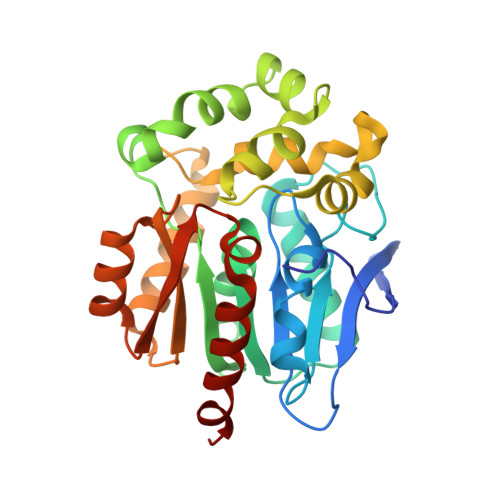Expansion of access tunnels and active-site cavities influence activity of haloalkane dehalogenases in organic cosolvents.
Stepankova, V., Khabiri, M., Brezovsky, J., Pavelka, A., Sykora, J., Amaro, M., Minofar, B., Prokop, Z., Hof, M., Ettrich, R., Chaloupkova, R., Damborsky, J.(2013) Chembiochem 14: 890-897
- PubMed: 23564727
- DOI: https://doi.org/10.1002/cbic.201200733
- Primary Citation of Related Structures:
4E46 - PubMed Abstract:
The use of enzymes for biocatalysis can be significantly enhanced by using organic cosolvents in the reaction mixtures. Selection of the cosolvent type and concentration range for an enzymatic reaction is challenging and requires extensive empirical testing. An understanding of protein-solvent interaction could provide a theoretical framework for rationalising the selection process. Here, the behaviour of three model enzymes (haloalkane dehalogenases) was investigated in the presence of three representative organic cosolvents (acetone, formamide, and isopropanol). Steady-state kinetics assays, molecular dynamics simulations, and time-resolved fluorescence spectroscopy were used to elucidate the molecular mechanisms of enzyme-solvent interactions. Cosolvent molecules entered the enzymes' access tunnels and active sites, enlarged their volumes with no change in overall protein structure, but surprisingly did not act as competitive inhibitors. At low concentrations, the cosolvents either enhanced catalysis by lowering K(0.5) and increasing k(cat), or caused enzyme inactivation by promoting substrate inhibition and decreasing k(cat). The induced activation and inhibition of the enzymes correlated with expansion of the active-site pockets and their occupancy by cosolvent molecules. The study demonstrates that quantitative analysis of the proportions of the access tunnels and active-sites occupied by organic solvent molecules provides the valuable information for rational selection of appropriate protein-solvent pair and effective cosolvent concentration.
Organizational Affiliation:
Loschmidt Laboratories, Department of Experimental Biology and Centre for Toxic Compounds in the Environment, Faculty of Science, Masaryk University, Kamenice 5A13, 625 00 Brno, Czech Republic.

















